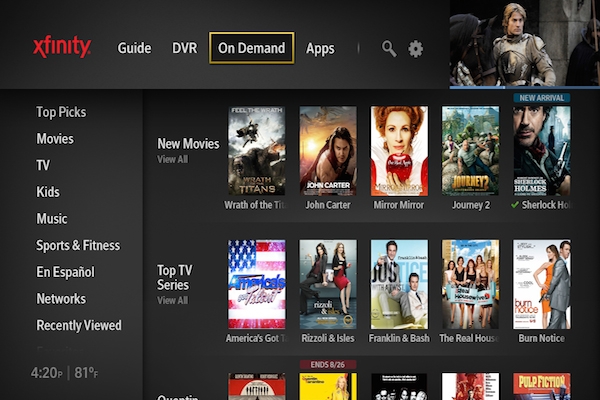The Denver Film Festival 39, which began last week, hosted an interesting panel session along with Comcast, “New Avenues of Distribution,” which focused on what the growing number of streaming TV services such as Hulu, Netflix, and Amazon, means for content creators, the film industry, and film-watchers alike.
On the panel was Comcast’s director of programming, Brett Hatch; the senior director of product management at Level 3, Jon Alexander; Stephan Shelanski, the former Starz executive vice president of programming acquisitions who is now on the other side as a film producer; and film critic and moderator of the panel (and long-time Denver Film Festival participant), Bob Denerstein.
During the session, Alexander was the proponent of streaming services like Netflix and Amazon, who have the freedom and capabilities to create niche content for specific audiences; free from the broadcast network model and Nielsen ratings pressure. Shelanski, now is his role as a filmmaker, discussed how the internet has created a double-edged sword, from enabling a plethora of content to be made available to consumers of that content, making it difficult for filmmakers to get above the fray, to the opening of more distribution doors for content creators and more formats, including short films, having the opportunity to be seen beyond the film festival circuit.
Hatch talked about how, as a content aggregator, Comcast goes about determining which networks to renew or seek out and which ones to let go, based on the IP data that informs them of which shows their subscribers are actually watching. With that insight, Comcast may choose not to renew a content distribution deal, even if the cost is only a few cents per subscriber, with the premise of not wanting to include that cost in a cable bundle when it doesn’t attract a viewing audience.
He also mentioned the aspect of advertising and targeting a given audience, “Every once in a while I’ll get caught watching a channel and an advertisement will come on, and that advertisement will not be geared toward me at all. I’ll think to myself, ‘Is this channel geared toward women? I’m not a woman, so why am I watching this?’”
When the Q&A time came, I asked Hatch a two part question: one, what were his thoughts on the potential for more targeted, addressable advertising, given the expansion of digitally delivered content and specifically, AT&T touting that one of the positive caveats to its acquistion of Time Warner was the ability to finally pull that off.
“The challenge with addressable inside the home, is that you’re not sure who’s watching,” he said. Right…because the limitations of a cable subscription, which could belong to one person or a family, is void of specific demographics of the viewer in the way that say, cookies can capture online behavior data of an individual in a browsing environment. “The question is, who is the commercial speaking to? That’s one of the main challenges.”
He continued by pointing out that addressable does exist with some of Xfinity’s on-demand content, “There’s a technology already that delivers specific advertising based on what content’s coming through.” This enables the advertiser to switch out spots depending on whom they’re targeting; ad spots that the viewer is forced to watch and isn’t able to skip through as opposed to shows recorded on their DVR. But again, this is the cable subscription scenario based on who they want to target, not customized to who is actually watching.
Since the topic of skinny bundles and new virtual MPVD services like DirecTV Now came up in conversation during the session, I had to ask when Comcast was going to offer something similar to stay competitive with the likes of DirectTV, Sling, or the anticipated subscription-based live television service from Google, YouTube Unplugged, which signed CBS network, its first major content partner.
“It exists today. Part of the X1 platform allows you to be able to take content with you. Anything you record on your cloud DVR you can take with you today,” Hatch answered. Asking to clarify if this feature required a cable subscription, he said, “Correct.”
Hatch continued, stating that additionally, a streaming-only service “Does exist today. There’s a small opportunity today that’s being marketed to millennials.” There was some laughter and eye-rolling in the crowd with the mention of the ‘M’ word. You can guess why.
Then things got a bit muddy, “Part of it is trying to navigate those waters of who owns content and how can that content get to, at the end of the day, our consumers. Some of that is wrapped up in just business deals, agreements and language around that. I think we were one of the first ones, no, excuse me, Time Warner was one of the first ones who said, ‘We’re going to just take content and make it available outside the home.’ And then Time Warner cable gets sued by the programmers to not allow that to happen. Certainly, there’s the aspect of trying be on that cutting edge, that bleeding edge. At some level, you do bleed because you do something that, someone who owns the content isn’t prepared to allow that to happen.”
One would expect that the original licensing agreement for cable distribution would need to be amended before an content aggregator actually made that content available to its subscribers in a streaming environment. And that’s not impossible, given how many players, including Hulu (of which Comcast owns a stake), are making live streaming announcements almost on a weekly basis.
In the end, Hatch confirmed that Comcast does not have an apples-to-apples type of DirecTV Now service, and there are no immediate plans to release one.




